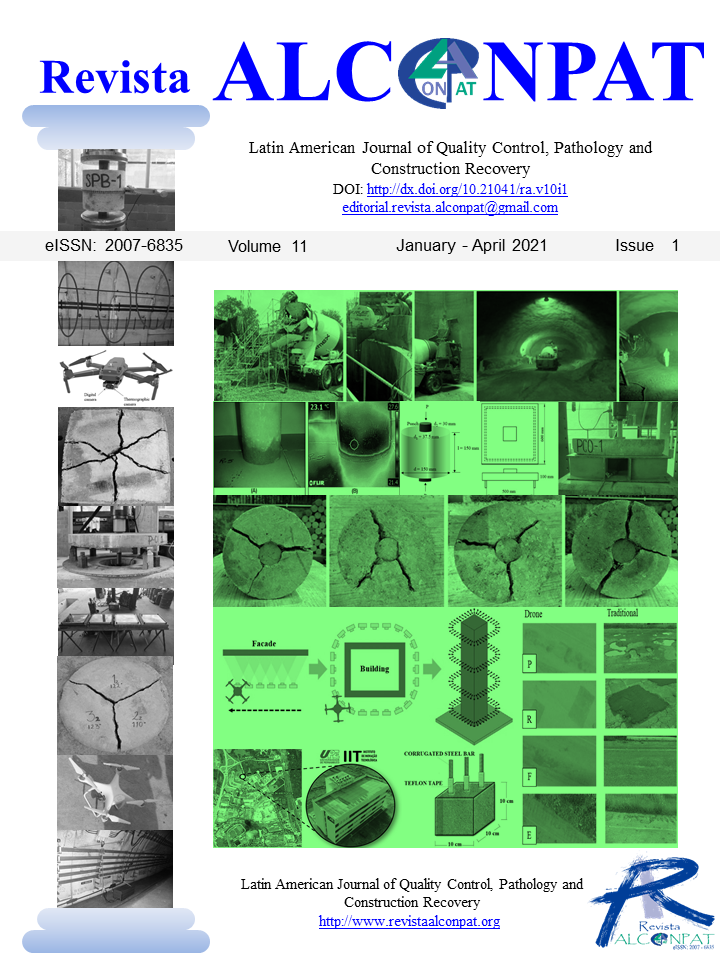Extension of the useful life of reinforced concrete structures exposed to marine environments through the application of electrochemical techniques
DOI:
https://doi.org/10.21041/ra.v11i1.518Keywords:
reinforced concrete, electrochemical chlorides extraction, cathodic protectionAbstract
In this work, the feasibility of a combined treatment of electrochemical chloride extraction (ECE) and cathodic protection (CP) in reinforced concrete structures using a conductive cement-graphite paste as anode has been studied. It has been proven that the prior application of an electrochemical chloride extraction treatment leads to greater durability of the anode. It has been shown that for reinforced concrete structures located in aggressive marine environments, the combination of electrochemical treatments, first ECE to reduce the chloride content and then CP to maintain passivation conditions, is capable of providing adequate protection conditions for the reinforcement, provided that the appropriate current density value is applied, according to the average content of chlorides present in the reinforced concrete structures.
Downloads
References
Andrade, C., Castellote, M., Alonso, C. (1998), An overview of electrochemical realkalisation and chloride extraction, in: D.W.S. Ho, I. Godson, F. Collins (Eds.), Rehabilitation of Structures, Proceedings of 2nd International RILEM/CSIRO/ACRA Conference, Melbourne, Australia, 21–23, September 1998, RILEM, Melbourne, Australia, pp. 1–12
Asociación Española de Normalización y Certificación (AENOR) (2009), (Ensayos de Hormigón Endurecido. Parte 3: Determinación de la Resistencia a Compresión de Probetas (Testing Hardened Concrete – Part 3: Compressive Strength of Test Specimens), Madrid, Spain.
Asociación Española de Normalización y Certificación (AENOR) (2014), UNE 83980:2014 Durabilidad del Hormigón. Métodos de Ensayo. Determinación de la Absorción de Agua, la Densidad y la Porosidad Accesible al Agua del Hormigón (Concrete Durability. Test Methods. Determination of the Water Absorption, Density and Accessible Porosity for Water in Concrete), Madrid, Spain, (in Spanish).
Asociación Española de Normalización y Certificación (AENOR) (2009), UNE EN 12390-7:2009 Ensayos de Hormigón Endurecido. Parte 7: Densidad del Hormigón Endurecido (Testing Hardened Concrete – Part 7: Density of Hardened Concrete), Madrid, Spain.
Bertolini, L., Elsener, B., Pedeferri, P., Polder, R. B. (2004), Electrochemical techniques, in: Corrosion of Steel in Concrete, Wiley-VCH, Weinheim, Germany, pp. 345–374.
Bertolini, L., Bolzoni, F., Pedeferri, P., Lazzari, L., Pastore, T. (1998), Cathodic protection and cathodic prevention in concrete principles and applications, Journal of Applied Electrochemistry. 28, 1321–1331. https://doi.org/10.1023/A:1003404428827
Carmona, J., Garcés, P., Climent, M. A. (2015a), Efficiency of a conductive cement-based anodic system for the application of cathodic protection, cathodic prevention and electrochemical chloride extraction to control corrosion in reinforced concrete structures, Corrosion Science, 96, 102–111. https://doi.org/10.1016/j.corsci.2015.04.012
Carmona, J., Climent, M. A., Antón, C., De Vera, G., Garcés, P. (2015b), Shape effect of electrochemical chloride extraction in structural reinforced concrete elements using a new cement-based anodic system, Materials, 8 (6), 2901–2917. https://doi.org/10.3390/ma8062901
Carmona, J., Climent, M. A., Garcés, P. (2017), Influence of different ways of chloride contamination on the efficiency of cathodic protection applied on structural reinforced concrete elements, Journal of Electroanalytical Chemistry. 793, 8–17. https://doi.org/10.1016/j.jelechem.2016.08.029
Cañón, A., Garcés, P., Climent, M. A., Carmona, J., Zornoza, E. (2013), Feasibility of electrochemical chloride extraction from structural reinforced concrete using a sprayed conductive graphite powder–cement as anode, Corrosion Science.77, 128–134. https://doi.org/10.1016/j.corsci.2013.07.035
Christodoulou, C., Glass, G. K., Webb, J., Austin, S., Goodier, C. (2010), Assessing the long term benefits of impressed current cathodic protection, Corrosion Science. 52, 2671–2679. https://doi.org/10.1016/j.corsci.2010.04.018
Climent, M. A., Viqueira, E., De Vera, G., López, M. M. (1999), Analysis of acid-soluble chloride in cement, mortar and concrete by potentiometric titration without filtration steps, Cement and Concrete Research. 29 (6), 893–898. https://doi.org/10.1016/S0008-8846(99)00063-0
Climent, M. A., De Vera, G., Viqueira, E., López, M.M. (2004), Generalization of the possibility of eliminating the filtration step in the determination of acid-soluble chloride content in cement and concrete by potentiometric titration, Cement and Concrete Research. 34 (12), 2291–2300. https://doi.org/10.1016/j.cemconres.2004.04.012
Climent, M. A., Sánchez de Rojas, Mª. J., De Vera, G., Garcés, P. (2006), Effect of type of anodic arrangements on the efficiency of electrochemical chloride removal from concrete. ACI Materials Journal 103, 243-250.
Climent, M. A., Carmona, J., Garcés, P. (2016), Graphite–cement paste: a new coating of reinforced concrete structural elements for the application of electrochemical anti-corrosion treatments, Coatings, 6 (3), 32. https://doi.org/10.3390/coatings6030032
Climent, M. A., Carmona, J., Garcés, P. (2019), Application of combined electrochemical treatments to reinforced concrete: Electrochemical chloride extraction plus cathodic protection, Hormigón y Acero, 69 (1), 43–51. https://doi.org/10.1016/j.hya.2018.05.003
Del Moral, B., Galao, O., Antón, C., Climent, M. A., Garcés, P. (2013), Usability of cement paste containing carbon nanofibres as an anode in electrochemical chloride extraction from concrete, Materiales de Construcción, 63(309), 39–48. https://doi.org/10.3989/mc.2012.031
Dugarte, M., Sagüés, A. A., Williams, K. (2015), Cathodic prevention for reinforcing steel in cracked concrete of chloride contaminated structures, in: Proceedings of CORROSION 2015 Conference, NACE-2015-6102, Houston, TX, USA, 15–19 March 2015, NACE International, Houston, TX, USA, p. 11.
Elsener, B., Molina, M., Böhni, H. (1993), The electrochemical removal of chlorides from reinforced concrete, Corrosion Science. 35 (5-8), 1563–1570. https://doi.org/10.1016/0010-938X(93)90385-T
Garcés, P., Sánchez de Rojas, M. J., Climent, M. A. (2006), Effect of the reinforcement bar arrangement on the efficiency of electrochemical chloride removal technique applied to the reinforced concrete structures, Corrosion Science. 48, 531–545. https://doi.org/10.1016/j.corsci.2005.02.010
Galao, O., Baeza, F. J., Zornoza, E., Garcés, P. (2014), Strain and damage sensing properties on multifunctional cement composites with CNF, Cement and Concrete Composites. 46, 90–98. https://doi.org/10.1016/j.cemconcomp.2013.11.009
Glass, G. K., Chadwick, J. R. (1994), An investigation into the mechanisms of protection afforded by a cathodic current and the implications for advances in the field of cathodic protection, Corrosion Science, 36 (12), 2193–2209. https://doi.org/10.1016/0010-938X(94)90017-5
Glass, G. K., Hassanein, A. M., Buenfeld, N. R. (2001), Cathodic protection afforded by an intermittent current applied to reinforced concrete, Corrosion Science. 43 (6), 1111–1131. https://doi.org/10.1016/S0010-938X(00)00133-5
Hansson, I. L. H., Hansson, C. M. (1993), Electrochemical extraction of chlorides from concrete. Part I – A qualitative model of the process, Cement and Concrete Research. 23 (5), 1141–1152. https://doi.org/10.1016/0008-8846(93)90174-8
ISO (2012), ISO 12696: 2012. Cathodic Protection of Steel in Concrete, Geneva, Switzerland.
Liu, Y., Shi, X. (2012), Modeling cathodic prevention for unconventional concrete in salt-laden environment, Anti-Corrosion Methods and Materials, 59 (3), pp. 121-131. https://doi.org/10.1108/00035591211224663
Mietz, J. (1998), Electrochemical rehabilitation methods for reinforced concretes structures: a state of the art report, in: Publication Number 24 of the European Federation of Corrosion, IOM Communications Ltd, London, UK, pp. 57
Page, C. L. (1992), Interfacial effects of electrochemical protection method applied to steel in chloride containing concrete, in: D.W.S. Ho, F. Collins (Eds.), Proceedings of the International RILEM/CSIRO/ACRA Conference on Rehabilitation of Concrete Structures, Melbourne, Australia 1992, RILEM, Melbourne, Australia, pp. 179–187.
Page, C. L. (1997), Cathodic protection of reinforced concrete. Principles and applications, in: Proceedings of the International Conference on Repair of Concrete Structures, Svolvaer, Norway, 1997, pp. 123–132
Pedeferri, P. (1996), Cathodic protection and cathodic prevention, Construction and Building Materials. 10 (5), 391–402. https://doi.org/10.1016/0950-0618(95)00017-8
Pedeferri, P., Bertolini, L. (2000), Tecniche elettrochimiche (Electrochemical techniques), in: La Durabilità del Calcestruzzo Armato (The Durability of Reinforced Concrete), McGraw-Hill, Milano, Italy, pp. 253–273. (In Italian).
Pérez, A., Climent, M. A., Garcés, P. (2010), Electrochemical extraction of chlorides from reinforced concrete using a conductive cement paste as the anode, Corrosion Science. 52 (5), 1576–1581. https://doi.org/10.1016/j.corsci.2010.01.016
Polder, R. B. (1998), Cathodic protection of reinforced-concrete structures in The Netherlands – experience and developments, Heron 43 (1),3–14
Polder, R. B. (2005), Electrochemical techniques for corrosion protection and maintenance, in: H. Böhni (Ed.), Corrosion in Reinforced Concrete Structures, Woodhead Publishing, Cambridge, UK, pp. 215–241
Sánchez de Rojas, M. J., Garcés, P., Climent, M. A. (2006), Electrochemical extraction of chlorides from reinforced concrete: variables affecting treatment efficiency, Materiales de Construcción, 56 (284), 17–26. https://doi.org/10.3989/mc.2006.v56.i284.15
Slater, J. E., Lankard, D. R., Moreland, P. J. (1976), Electrochemical removal of chlorides from concrete bridge decks, Materials Performance, 56, 21–26.
Tritthart, J. (1998), Electrochemical Chloride Removal: An Overview and Scientific Aspects, The American Ceramic Society, Westerville, OH, USA, pp. 401–441
Vennesland, Ø., Climent, M. A., Andrade, C. (2013), Recommendation of RILEM TC 178-TMC: testing and modelling chloride penetration in concrete, Methods for obtaining dust samples by means of grinding concrete in order to determine the chloride concentration profile, Materials and Structures. 46, 337–344. https://doi.org/10.1617/s11527-012-9968-1
Vennesland, Ø., Opsahl, O.A., Russell-Rayner, A. P. (1986), Removal of chlorides from concrete. European Patent Application number 86302888.2. Publication number 0 200 428.
Downloads
Published
How to Cite
Issue
Section
License
_______________________________
License in effect from September 2020
You are free to:
- Share — copy and redistribute the material in any medium or format for any purpose, even commercially.
- Adapt — remix, transform, and build upon the material for any purpose, even commercially.
- The licensor cannot revoke these freedoms as long as you follow the license terms.
Under the following terms:
- Attribution — You must give appropriate credit , provide a link to the license, and indicate if changes were made . You may do so in any reasonable manner, but not in any way that suggests the licensor endorses you or your use.
- No additional restrictions — You may not apply legal terms or technological measures that legally restrict others from doing anything the license permits.
Notices:
You do not have to comply with the license for elements of the material in the public domain or where your use is permitted by an applicable exception or limitation .
No warranties are given. The license may not give you all of the permissions necessary for your intended use. For example, other rights such as publicity, privacy, or moral rights may limit how you use the material.





















.png)














